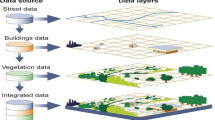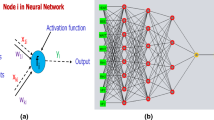Abstract
The main objective of this study is to investigate the potential of artificial neural network (ANN) for integration with geographical information system (GIS) to assess the suitability of land to cultivate a selected crop. For this purpose, requirements of a system for intelligent assessment of land suitably were determined and the architecture of the integrated system was designed according to capabilities of ANN and GIS. For evaluation of the integrated system performance, a case study was carried out in the Mazandaran Province, located in the northern part of Iran. In the system implemented for the case study, four effective parameters in crop cultivation were utilized in the multilayer feed-forward back-propagation neural network analysis. The activation function of the hidden layer was set to log-sigmoid function. Designed ANN was trained using the samples extracted from GIS database, and 4-6-1 (4 input parameters as input layer, 6 neurons in hidden layer and 1 target value representing suitability level) structure shows the best result. Evaluation of the system shows that 83.43 % of ANN’s results are acceptable and consistent with the real world.







Similar content being viewed by others
References
Wang D, Li C, Song X, Wang J, Yang X, Huang W, Wang J, Zhou J (2011) Assessment of land suitability potentials for selecting winter wheat cultivation areas in Beijing, China, using RS and GIS. Agric Sci China 10(9):1419–1430
Duc TT (2006) Using GIS and AHP technique for land-use suitability analysis. International symposium on geoinformatics for spatial infrastructure development in earth and allied sciences (GIS-IDEAS 2006), pp 9–11
Bandyopadhyay S, Jaiswal RK, Hegde VS, Jayaraman V (2009) Assessment of land suitability potentials for agriculture using a remote sensing and GIS based approach. Int J Remote Sens 30(4):879–895
Wang F, Hall GB, Subaryono J (1990) Fuzzy information representation and processing in conventional GIS software: database design and applications. Int J Geogr Inf Syst 4:261–283
Al-Shalabi MA, Mansor SB, Ahmed NB, Shiriff R (2006) GIS based multicriteria approaches to housing site suitability assessment. In: XXIII FIG congress
Feizizadeh B, Blaschke T (2012) Land suitability analysis for Tabriz County, Iran: a multi-criteria evaluation approach using GIS. J Environ Plan Manag 1–23
Bandyopadhyay S, Jaiswal RK, Hegde VS, Jayaraman V (2009) Assessment of land suitability potentials for agriculture using a remote sensing and GIS based approach. Int J Remote Sens 30(4):879–895
Akbulak C (2010) Analitik Hiyerars_i Süreci ve Cog ˘rafi Bilgi Sistemleri ile Yukarı Kara Menderes Havzası’nın Arazi Kullanımı Uygunluk Analizi. Uluslararası_ Insan Bilimleri Dergisi 7(2):557–576
Zengin M, Yılmaz S (2008) Ardahan Kura Nehri ve Yakın Çevresi Alan Kullanımlarının Belirlenmesi ve Optimal Alan Kullanım Önerileri. Atatürk Üniversitesi Ziraat Fakültesi Dergisi 39(1):43–54
Prakash TN (2003) Land suitability analysis for agricultural crops: a fuzzy multicriteria decision making approach. MSc thesis, The International Institute for Geo-information Science and Earth Observation (ITC), Enschede
Brail RK, Klosterman RE (2001) Planning support systems
Collins MG, Steiner FR, Rushman MJ (2001) Land-use suitability analysis in the United States: historical development and promising technological achievements. Environ Manag 28(5):611–621
Malczewski J (2004) GIS-based land-use suitability analysis: a critical overview. Prog Plann 62:3–65
Perveen MF, Nagasawa R, Uddin MI, Delowar HKM (2007) Crop-land suitability analysis using a multicriteria evaluation and GIS approach. In: 5th international symposium on digital earth (ISDE5)
Mustafa AA, Singh M, Sahoo RN, Ahmed N, Khanna M, Sarangi A, Mishra AK (2011) Land suitability analysis for different crops: a multi criteria decision making approach using remote sensing and GIS. Researcher 3:61–84
Mokarram M, Aminzadeh F (2010) GIS-based multicriteria land suitability evaluation using ordered weight averaging with fuzzy quantifier: a case study in Shavur Plain, Iran. Int Arch Photogr Remote Sens Spatial Inf Sci 38(II):508–512
Mendas A, Delali A (2012) Integration of multicriteria decision analysis in GIS to develop land suitability for agriculture: application to durum wheat cultivation in the region of Mleta in Algeria. Comput Electron Agric 83:117–126
Hossain MS, Das NG (2010) GIS-based multi-criteria evaluation to land suitability modelling for giant prawn (Macrobrachium rosenbergii) farming in Companigonj Upazila of Noakhali, Bangladesh. Comput Electron Agric 70:172–186
Akıncı H, Özalp AY, Turgut B (2013) Agricultural land use suitability analysis using GIS and AHP technique. Comput Electron Agric 97:71–82
FAO (1976) A framework for land evaluation. FAO Soils Bulletin No. 32, Rome
FAO (1984) Guidelines for land evaluation for rainfed agriculture. Soils Bulletin, No. 52. Rome
FAO (1985) Guidelines: land evaluation for irrigated agriculture. Guidelines: land evaluation for irrigated agriculture
Sys C, Van Ranst E, Debaveye IJ (1991) Land evaluation. Part I: principles. In: Land evaluation and crop production calculations. General Administration for Development Cooperation, Agricultural publication No. 7, Brussels, Belgium, 274 pp
Sys C, Van Ranst E, Debaveye IJ (1991) Land evaluation. Part II: methods in land evaluation. General Administration for Development Cooperation, Agricultural publication No. 7, Brussels, Belgium, 247 pp
Bydekerke L, Van Ranst E, Vanmechelen L, Groenemans R (1998) Land suitability assessment for cherimoya in southern Ecuador using expert knowledge and GIS. Agric Ecosyst Environ 69:89–98
Tien Bui D, Pradhan B, Lofman O, Revhaug I, Dick OB (2012) Landslide susceptibility assessment in the Hoa Binh province of Vietnam: a comparison of the Levenberg–Marquardt and Bayesian regularized neural networks. Geomorphology 171–172:12–29
Burrough PA, McDonnell R (1998) Principles of geographical information systems. Oxford University Press, New York, p 333
Sui DZ (1993) Integrating neural networks with GIS for spatial decision making. Oper Geogr 11(2):13–20
Zhou J, Civco DL (1996) Using genetic learning neural networks for spatial decision making in GIS. Photogr Eng Remote Sens 11:1287–1295
Krzanowski R, Raper J (2001) Spatial evolutionary modeling. Oxford University Press, Oxford
Batty M, Xie Y (1994) From cells to cities. Environ Plan 21:31–48
Paola JD, Schowengerdt RA (1995) A review and analysis of backpropagation neural networks for classification of remotely sensed multi-spectral imagery. Int J Remote Sens 16:3033–3058
Lee S, Ryu JH, Min KD, Won JS (2003) Landslide susceptibility analysis using GIS and artificial neural network. Earth Surf Proc Land 28:1361–1376
Kawabata D, Bandibas J (2009) Landslide susceptibility mapping using geological data, a DEM from ASTER images and an artificial neural network (ANN). Geomorphology 113:97–109
Garcia-Rodriguez MJ, Malpica JA (2010) Assessment of earthquake-triggered landslide susceptibility in El Salvador based on an artificial neural network model. Nat Hazards Earth Syst Sci 10:1307–1315
Haykin S (1998) Neural networks: a comprehensive foundation, 2nd edn. Prentice Hall, Upper Saddle River
Pijanowski BC, Brown DG, Shellito BA, Manik GA (2002) Using neural networks and GIS to forecast land use changes: a land transformation model. Comput Environ Urban Syst 26(6):553–575
Nisar Ahamed TR, Gopal Rao K, Murthy JSR (2000) GIS-based fuzzy membership model for crop-land suitability analysis. Agricultural Systems. 63. www.elsevier.com/locate/agsy
Bunruamkaew K, Murayam Y (2011) Site suitability evaluation for ecotourism using GIS & AHP: a case study of Surat Thani Province, Thailand. Proc Soc Behav Sci 21:269–278
Ermini L, Catani F, Casagli N (2005) Artificial neural networks applied to landslide susceptibility assessment. Geomorphology 66:327–343
Vahidnia MH, Alesheikh AA, Alimohammadi A, Hosseinali F (2010) A GIS-based neuro-fuzzy procedure for integrating knowledge and data in landslide susceptibility mapping. Comput Geosci 36:1101–1114
Gomez H, Kavzoglu T (2005) Assessment of shallow landslide susceptibility using artificial neural networks in Jabonosa River Basin, Venezuela. Eng Geol 78:11–27
Vahidnia MH, Alesheikh AA, Alimohammadi A, Hosseinali F (2009) Landslide hazard zonation using quantitative methods in GIS. Int J Civil Eng 7:176–189
Lee S, Ryu JH, Won JS, Park HJ (2004) Determination and application of the weights for landslide susceptibility mapping using an artificial neural network. Eng Geol 71:289–302
Maier HR, Dandy GC (1996) The use of artificial neural networks for the prediction of water quality parameters. Water Resour Res 32(4):1013–1022
Jain SK, Nayak PC, Sudheer KP (2008) Models for estimating evapotranspiration using artificial neural networks, and their physical interpretation. Phys Interpret 22:2225–2234
Talaee PH (2014) Multilayer perceptron with different training algorithms for streamflow forecasting. Neural Comput Appl 24:695–703
Samanta B, Bandopadhyay S, Ganguli R (2006) Comparative evaluation of neural network learning algorithms for ore grade estimation. Math Geol 38:175–197
Beale R, Jackson T (1990) Neural computation: an introduction, 1st edn. Institute of Physics Publishing, Williston
Pradhan B, Lee S (2010) Delineation of landslide hazard areas on Penang Island, Malaysia, by using frequency ratio, logistic regression, and artificial neural network models. Environ Earth Sci 60(5):1037–1054
Author information
Authors and Affiliations
Corresponding author
Rights and permissions
About this article
Cite this article
Farnood Ahmadi, F., Farsad Layegh, N. Integration of artificial neural network and geographical information system for intelligent assessment of land suitability for the cultivation of a selected crop. Neural Comput & Applic 26, 1311–1320 (2015). https://doi.org/10.1007/s00521-014-1801-z
Received:
Accepted:
Published:
Issue Date:
DOI: https://doi.org/10.1007/s00521-014-1801-z




